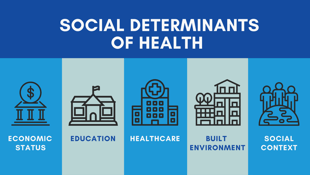How Health Plans Can Use SDoH Data to Succeed in Value-Based Care
COVID-19 has reignited the conversation regarding social determinants of health (SDoH) as certain minority groups are at a greater risk for...


A risk bearing entity, whether it is a health plan, an ACO, or an IPA, should consider including SDoH contracting into their Value-Based Care (VBC) arrangements. This is especially important now as SDoH factors are being incorporated into CMS contracting initiatives for government-sponsored plans (Medicare, Medicare Advantage, and Medicaid) for improving health. CMS has constructed innovative payment models such as the CMMI “Direct Contracting Model or Geo” which launches in 2022.
Many factors outside of a clinical setting—transportation, nutrition, housing, employment, health literacy, etc.—are seen to have an indirect but significant impact on care. Today it’s estimated that 80-90 percent of patient outcomes are affected by some form of SDoH factor[i].
-1.png?width=770&name=SDoH-enhanced-graphic%20(Horizontal)-1.png)
Managing SDOH has a return on investment (ROI). This is good news as organizations tackle this very real challenge. Avoidable hospital admissions and emergency department visits are big drivers of unnecessary spending. But many of these instances can be avoided, thus reducing cost of care, by enabling your providers to connect their patients with the right Community-Based Organizations (CBOs). By comparison, these interventions are low-cost.
The key players for improving SDoH are providers, care coordinators, and CBOs. Technology plays a central role for aggregation, alignment, and insight. An electronic SDoH management system can facilitate contracting, participant interactions, timely payouts, and improved performance against goal. The two key components of an effective electronic SDoH management system are a:
An SDoH contract navigation system allows health plans and ACOs to contract with providers and CBOs to screen, refer, coordinate care, and effectively engage members/patients with SDoH issues, and make timely payments based on certain well-defined metrics. Examples of metrics include:
Payments could be made as direct contracts with CBOs or IPAs, or by providing an additional care management fee to providers as a non-claims expense.
The closed loop workflow and referral system enables all of the activities mentioned above. It enables screening of members/patients, timely referrals to appropriate CBOs, and tracking of activity. A key component of this system is making sure the care team is coordinated throughout the entire patient journey. To this end, clearly defined roles must be established for screening, recording, providing interventions, and tracking performance.
Both the navigation framework and the closed loop workflow and referral system are important for a successful electronic SDoH management system.
As your program continues, you’ll begin to see benefits. One health plan reported an average reduction of $2,443 in second year medical expenditures for individuals who received coordinated referral services to address social needs[ii]. Another plan demonstrated a 21 percent reduction of inpatient use of services year over year, resulting in a 22 percent reduction in PMPM cost, a 31 percent decline in ED use, and a 11.6 percent reduction in overall costs[iii].
Social determinants of health present an exciting opportunity to transform care. Addressing SDoH also impacts the communities you serve. By leveraging technology, you can generate cost savings and avoid unnecessary healthcare spending.
[i] Screening for Social Determinants of Health: An Opportunity or Unreasonable Burden? https://www.aafp.org/fpm/2018/0500/p3.html
[ii] Health Plan Addresses Social Issues with Data. https://www.healthleadersmedia.com/finance/health-plan-addresses-social-issues-data
[iii] Vermont Blueprint for Health. https://blueprintforhealth.vermont.gov/sites/bfh/files/Vermont%20Blueprint%20for%20Health%202010%20Annual%20Report.pdf

Raj Lakhanpal

COVID-19 has reignited the conversation regarding social determinants of health (SDoH) as certain minority groups are at a greater risk for...

For the past ten years social determinants of Health (SDoH) have gained greater importance from health care organizations and legislators, and the...